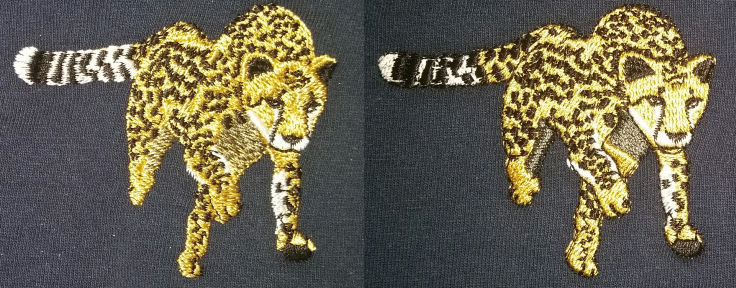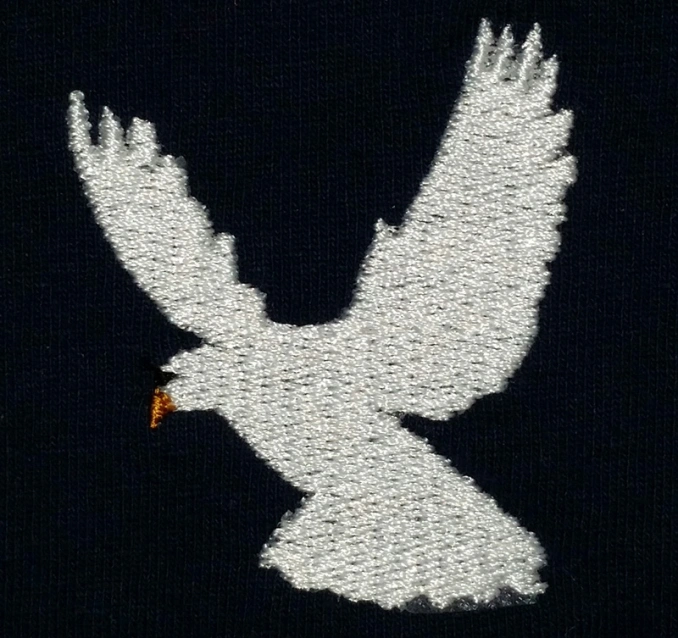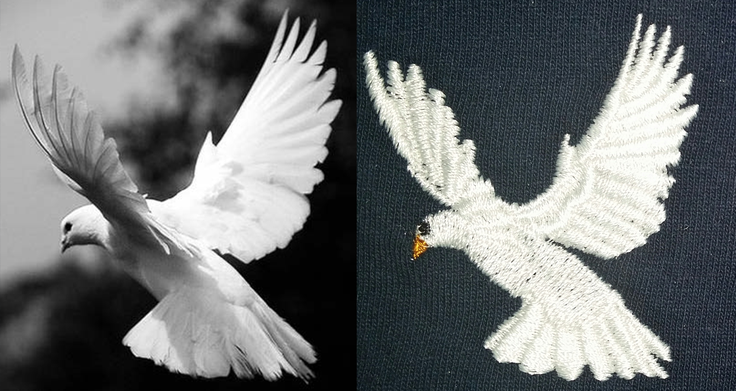Digitizing Animals
We are going to look at this subject with a rather broad brush. This article will handle the basics of how to approach digitizing for animals.
I use Wilcom as my primary digitizing program so most of my specifications will focus on this software although Pulse can be used in a similar fashion.
The first thing is to determine how complicated you are going to make it. Are there going to be a lot of thread colors? Do you want to tackle blends in areas? I find that the more thread colors in an animal’s fur, the more a more difficult time I have in mapping out strategies. It looks better but is more difficult. If you don’t have a lot of experience in digitizing creatively, I recommend you keep fur down to one main color, a highlight color, and a shadow color. Leave black and white for things like white for eyes, black for outline of eyes and nose.
Overlap satin stitches to mimic the pattern of feathers. It does not have to be identical. Do not use this technique if the feathers have a narrow width. You want approximately 2.5 mm to 7 mm in width. Order is crucial to make the feathers look believable. I prefer not to represent shading in feathers because it can look like feather color and not shadow.

Since I started digitizing way back when there were tablets and pucks involved, I like the idea of mapping out stitch direction. I try to keep my stitch direction relevant to my rule: vertical stitches look higher and horizontal stitches look flat. Add that to the rule: foreground is closer than background, you will have a starting point. Background fill will be closer to horizontal stitching and foreground (the animal in this case) will be with angled and near vertical stitches. Now consider how the fur lays and you should have an idea of how to map your stitch direction.
Fur
When dealing with fur, I like to make my own random pattern. In Wilcom, your default object properties for Tatami (Ceeding or fill stitch) are Stitch Length: 4.00mm and Offset fraction of A: 25 B: 25 and finally a random of 0. With short hair fur, try a Length of 4.00mm and Offset fraction of A: .5 B: 0 and a random of 50. With long hair I will vary the stitch length between 4 and 6 mm and an offset fraction of A: 1.0 B: 0. This is a sharper delineation of a pattern, so the random pattern needs to be greater, from 70%-90%.

Using fill patterns, you may be used to creating an edge run underlay to keep the fill to be sharp and clean. You want to do the exact opposite with fur. Let it be rough. You may even want to use a jagged edge for a rougher look.
Another thing that helps give realness to embroidery is color order. If there are patches of fur that are darker due to shading, I prefer to embroider the darkest color first and each following color get brighter or whiter in succession.
If you are doing detail such as stripes or spots on an animal, keep in mind this is fur. The rules you have learned before about proper underlay or keeping edges clean do not apply here. On the cheetah I have no underlay in the spots. Roughness is okay and even preferred in approaching fur. When dealing with a lot of spots such as the cheetah, try to limit your trims. You can do so by keeping your jumps in the same direction as the fill lays, thus eliminating a ton of trims. Your embroiderer will thank you.

Birds
 Fig 5 – One Shape Fill
Fig 5 – One Shape Fill
I’ve seen a lot of people digitize birds with one shape being a plain fill(fig 5). This is the easiest way to do it, but definitely the least attractive. I like defining the bird’s individual feathers if possible. If the bird is small and has many tiny feathers, feel free and simplify the feathers. Most people will not count and compare the number of feathers between the picture and the embroidery. If you do a bird that has 1 mm wide feathers and you are overlapping the feathers with 1.5 mm wide satin stitches, this becomes a lot of stitches in a small area. Too many stitches can cause the thread to break or fray and can often warp in the area concerned.
Direction of stitches counts. Try angling the satin stitch to go the same direction as the barb of the feather. Also, vary the angle slightly from each adjacent feather so as to keep the stitches from feathering (irony.) An edge run underlay will help too.

Order means a lot when doing wings. If one feather is behind another, try keeping the order the same way. If a feather is supposed to be on top, don’t digitize it first. As always, try things out and see what you prefer. Experiment with textures and angles and you will only get better.
